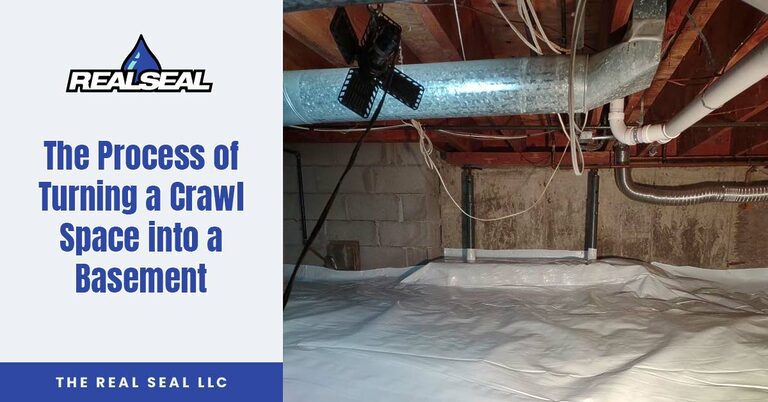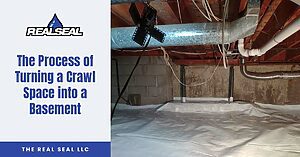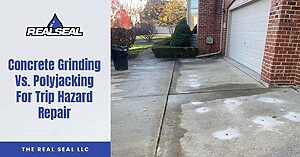Converting a crawl space into a full basement requires time, energy, and money. Still, this service may be worth it to some folks. The best way to understand if transforming a crawl space into a basement is right for you is to understand the main steps involved, the pros and cons, and other possible options.
How to Convert a Crawl Space into a Basement
Turning a crawl space into a basement is challenging but possible. Here are the primary steps:
- Assess the current crawl space: Before transforming a crawl space into a basement, it’s essential to evaluate the state of the foundation. Step one involves assessing the crawl space to ensure a possible transition to a full basement. Your foundation team should also notice any water-related problems or other issues with your crawl space. That team should address these problems before starting the transition project or fix them during the conversion. Only after ensuring that a crawl space can convert to a full basement and that current crawl space issues can be resolved should the team proceed to the next steps.
- Provide support for the home: There are multiple ways to get this done. If the underpinning involves lowering the foundation section-by-section, all they will need to do is lower the I-Beam supports and create proper footings first. Once the I-Beam is secure, the foundation can be dug out in 4-5 foot sections and the lower foundation poured underneath. The remaining foundation is enough to support the home while the work is being done. If the company is going to lower and pour the entire foundation at once, a cribbing or scaffolding support system will need to be installed in the interim while the work is being completed.
- Dig out the crawl space: During this stage, the construction team will dig below the home and remove all unnecessary elements of the crawl space and other unwanted materials. Digging to a depth of at least six to eight feet ensures that the basement will be full-sized, nearly matching the living spaces in your home.
- Create a full basement foundation: The next step is to create a full foundation after excavation. Your foundation team may achieve this by pouring concrete, laying masonry, or using other materials. Either way, the foundation should extend to a total depth of six to eight feet and will connect to the remnants of the crawl space.
- Connect the home to the foundation: After the foundation is in place, your foundation team can release the home from its scaffolding and connect it to the new foundation. This new foundation should support the home and provide an entire basement space.
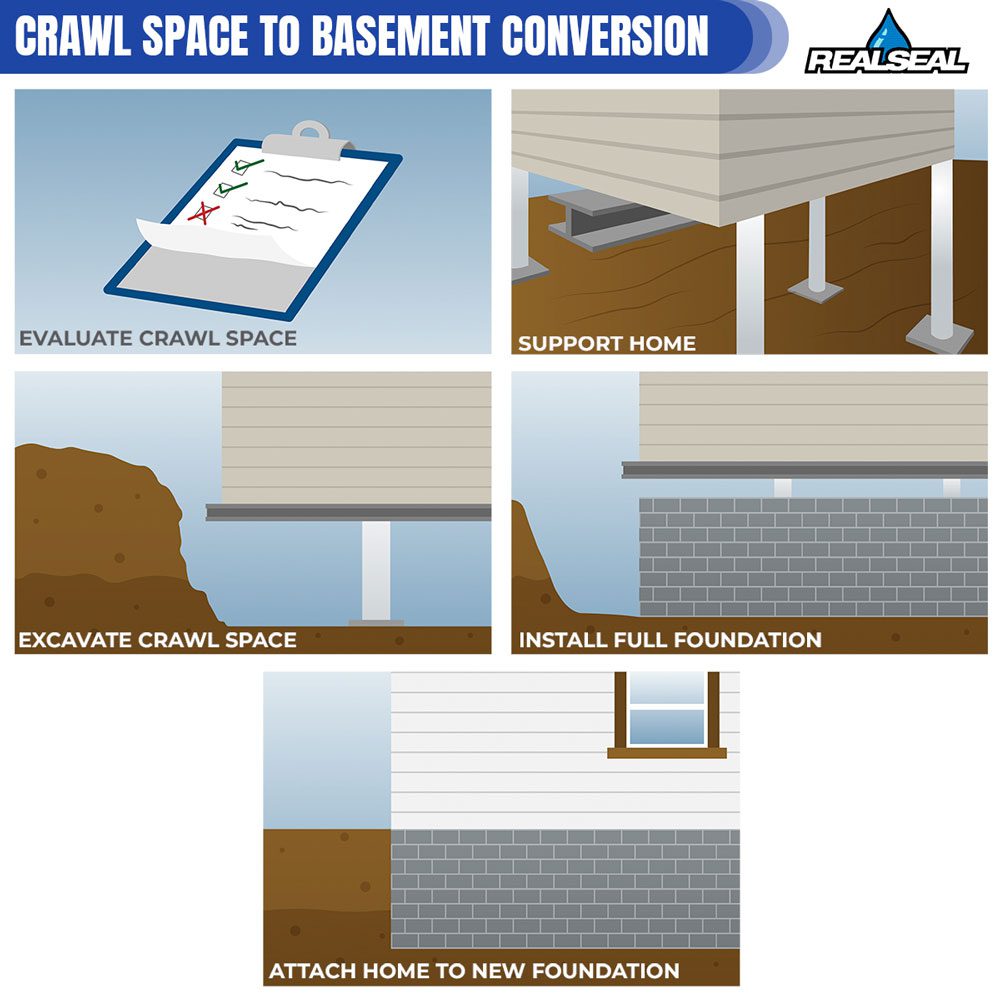
How Much Does it Cost to Convert a Crawl Space to a Full Basement?
Conversion from a crawl space to a full basement is not an option for those without disposable income. This process is monumental in scale and costs a lot of money upfront. The total cost of a transformation can vary depending on many factors. However, we estimate that most switches from a crawl space to a full basement cost between $50,000 and $150,000.
How Long Does it Take to Transform a Crawl Space into a Full Basement?
Another downside to transforming a crawl space into a basement is the amount of time it takes. In general, it takes, at the very least, a couple weeks to complete this conversion. However, it could also take several weeks or months to complete this job if it proves to be complicated for the foundation team.
Can You Stay in Your Home During a Crawl Space to Full Basement Conversion?
Depending on the technique used, you may need to move out of your home during the work. If a full cribbing system is being put in place, it’s best that you find somewhere else to stay while the work is being done.
If the contractor is lowering the foundation section by section, it is okay for you to stay in your home. You may still want to spend a night or two away for noise/dust purposes or while the contractor is re-connecting your water/gas/electrical lines that may have needed to be moved.
Is it Dangerous to Transition a Crawl Space to a Full Basement?
Converting a crawl space to a full basement is dangerous, even if the team you hire has experience. This transition requires the foundation team to excavate and work directly below the home. This factor and others make this a dangerous project if the correct precautions are not taken, safety is not held as the utmost importance, and lack of experience.
Are Crawl Space to Basement Conversions Always Successful?
Even if converting your crawl space to a basement is successful, problems may arise later. Problems may even arise during the conversion process. Additionally, the connection point between the former crawl space and the foundation is a weak point where water may leak inside. You may also find that your foundation requires other repairs following this transition.
Typically, waterproofing systems are installed with these basement conversions in order to head off any water issues.
What to Do Instead of a Conversion
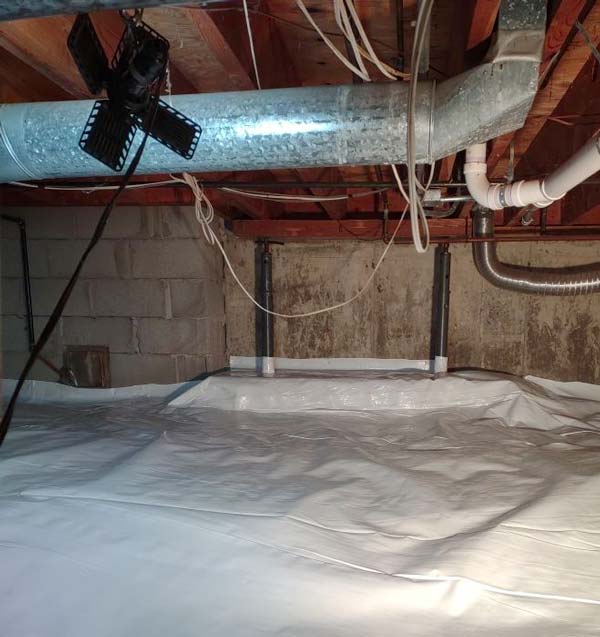
The cons of converting a crawl space to a basement deter many. The list below shows some options you can choose instead of this extensive project:
- Create an above-ground addition that provides additional living space.
- Encapsulate your crawl space to ensure moisture never becomes a problem.
- Perform any necessary repairs on your crawl space rather than converting it.
Talk to a Professional Team Before Converting a Crawl Space
As you can see, there are many considerations to make before converting a crawl space into a basement. Similarly, there are plenty of reasons why you should avoid this project. Still, this transformation may be worth it to some homeowners. If you are considering this project, the best approach is to find a crawl space professional you can rely on.
The best team you can choose is The Real Seal for anyone in the Chicagoland area. We have extensive experience with crawl spaces and foundations, and we are happy to discuss the state of your foundation. Contact us today to learn more about the services we provide.
